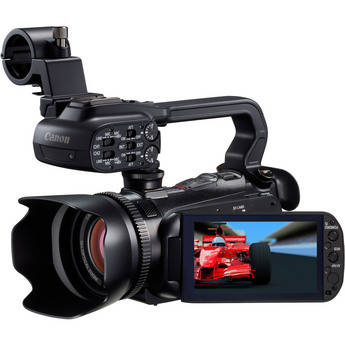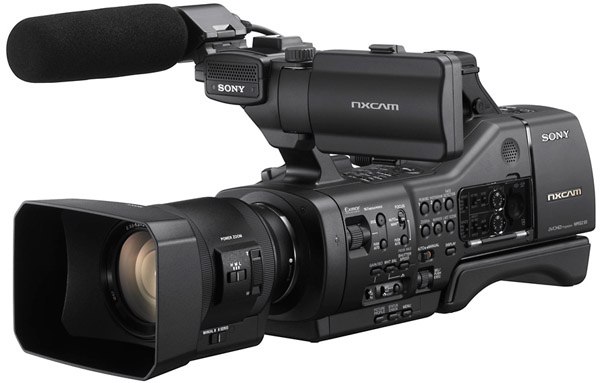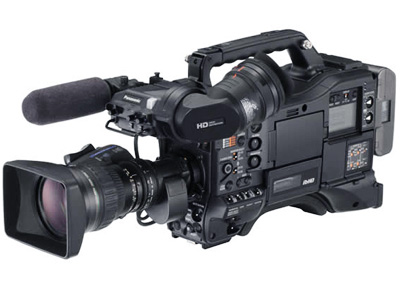TV stations mull myriad of ENG camera choices
Faced with so many conventional (camcorders) and unconventional (smart phones and DSLRs) options, it should not be surprising that TV news videographers and others involved in electronic newsgathering (ENG) are more than a bit confused about what camera to buy. And historically, when the market is confused, it results in lackluster sales.
While none of the camera manufacturers we spoke to would publicly divulge actual sales figures, it’s become clear that the camera market is highly competitive with very low profit margins. Many we talked to say that roughly $6,000 appears to be the “sweet spot” in terms of cost for field ENG customers. About $10,000 should buy you a respectable studio configured model.
Indeed, there’s no mistaking that a market that was once dominated by high-priced CCD imagers is now highly fragmented between proven CCDs and the more affordable CMOS sensors. It’s gotten to the point where many professionals are asking, “what’s an ENG camera, anymore?’”
“There’s so much noise and confusion in the marketplace that customers don't know which way to turn,” said Emilio Aleman, engineering manager at Hitachi Kokusai Electric America. TV stations use the company’s 3-CCD Z-HD5000 camcorders in the studio and out in the field. “I’m wondering why there is so much confusion because a three-chip camera still makes the best pictures for news.”

The “noise” he’s referring to is the emergence of digital SLR (single lens reflex) cameras that record full-motion, 1080p HD video on a single CMOS sensor. The concept has led to relatively inexpensive cameras, although many of these camera lack the features—audio inputs, adequate viewfinder—that make a “broadcast ENG” camera what is has always become known for.
Due to this imager invasion, ENG camera manufacturers, like Hitachi, Canon, Ikegami, Panasonic, and Sony, have all had to slash prices and develop new CMOS-centric models to meet their sales quotas. Some, like Hitachi, Ikegami and JVC have held fast to the CCD image sensor, noting its superior recording results in terms of signal-to-noise ratios and extended depth of field. Others, like Sony—with its NEX-EA50EH—have tried to bridge the gap with “hybrid” cameras that look like a conventional shoulder-mount ENG camera, but includes a single Super35 (CMOS) sensor.

Canon USA has also worked hard to sell its newest XF300 and XF305 camcorders as well as the less costly XA10 (under $2,000) to stations across the country, while at the same time its 5D MkIII and 7D MkIII single sensor-based DSLRs are being used virtually everywhere. That’s got to be tough for a sales rep to reconcile.
The professional video industry's #1 source for news, trends and product and tech information. Sign up below.
KRGV, an ABC affiliate in Weslaco, Texas, uses handheld XA10 HD camcorders equipped with infrared features for shooting in total darkness. In 2011 reporter Jordan Williams and photographer Mike Ortiz accompanied sheriff’s deputies on night patrols and used the XA10 HD camcorders to produce the Lone Star Emmy Award-winning “The Battle in Brooks County;” which documents the perils of illegal immigrants abandoned by human traffickers in the deserts of southern Texas. They attribute part of their success to the camera’s unobtrusive size and unique features.
"As the station's former chief photographer I know cameras,” said Israel Alfaro operations manager at KRGV. “I do the budget for the news department, and look for equipment that can help the news team. The Canon XA10 caught my attention because of its infrared features. We do a lot of undercover news here in South Texas, where nights are dark out in the brush of ranch country. The XA10 also caught my attention for its HD image quality, professional features, mobility, and file-based workflow convenience. It’s just like connecting an external hard drive to your computer editor. It’s also very cost-effective [so] we purchased a second one.”
WMHT-TV, the public broadcaster in Troy, NY, upgraded its production and broadcast facilities earlier this year with five Ikegami HDK-77EC HD CMOS sensor camera systems. The HDK-77EC is a docking-style portable multiformat HD camera with three 2.5 megapixel CMOS imaging sensors that support interlace and progressive performance and offer reduced power consumption and lower operating temperature. The camera can be used with the company's CCU-890M camera control unit for built-in fiber and optional triax connectivity. WMHT chose to use a triax connection for its five HDK-77EC cameras.

Anthony Tassarotti, the station’s CTO , said WMHT-TV selected the cameras after a shootout that included at least five different camera models and manufacturers The picture quality and reliability of the Ikegami's HDK-77EC cameras were key factors in their selection.
Still, there’s no denying the tough economy and limited equipment budgets TV stations are now faced with. When you're trying to get as many reporters on the street as possible, low cost is a chief concern.
“The trend is definitely toward lighter and more compact cameras, with both shoulder-mount and handheld models,” said Dave Walton, Assistant Vice President, Marketing Communications, JVC Professional Products Company. “The performance of our cameras has evolved to the point that our compact shoulder cameras are replacing larger dedicated studio cameras. In fact, a significant amount of our business is to organizations replacing earlier HD cameras that use proprietary, expensive media in favor of the more economical SDHC media.”
Indeed, JVC’s most popular ENG camera, the GY-HM790, has literally changed the way news gatherers look at an ENG camera and how it needs to perform to be “good enough” for local TV newscasts. Yet JVC is not ready to concede to the DSLR onslaught just yet.
“While any camera, including cell phones, can capture news—and many often do—broadcasters require certain features that are not found on the consumer models,” Walton said. “Broadcasters realize that day in, day out usage places heavy demands on an ENG camera—and most consumer models are just not up to the task.”
At Sony, Tatsuro Kurachi, director, PSD Product Marketing, Professional Solutions of America, agrees, although he admits that the marketplace is very difficult for a sales director to pin down. Sony’s XDCAM optical disc and NXCAM solid-state lines continue to sell reasonably well into TV stations and for reality TV production.

“We know broadcasters want certain tools and features, but they also want low prices and rigged camcorders that can withstand the challenges of ENG shooting,” he said. “Here at Sony we have noticed that many of our consumer cameras are being used for certain types of ENG applications, but it’s not the norm. The challenge for Sony is convincing customers of that fact. Some only look at the price because they have to outfit many crews. That’s logical, because larger station group that buy large quantities of equipment have to be budget conscious. Yet there’s a lot more to buying a camera than just the price point. You have to look at your entire workflow and what you want to accomplish.”
“Even before the recession, local television stations have been working to maximize their technology budgets in every way possible,” said Carter Hoskins, national sales manager, Media & Entertainment Group, Panasonic System Communications
Company. “In regards to ENG and studio acquisition systems, our customers are adding more and more cameras in order to increase live and pre-produced programming. Increased content and camera views are the goal. But they are requiring these cameras to be increasingly cost-effective and highly featured. Efficient and cost-effective content workflow is a top requirement today.”
Panasonic was the first camera manufacturer to provide solid-state field recording solutions to the professional video market with our launch of P2 in 2003. The migration to file-based acquisition and production has been ongoing and the benefits of speed and portability are clear. The company’s AJ-HPX3100 and AG-HPX370 shoulder-mount cameras have been “great sellers,” according to Hoskins, and to date well over 250,000 P2 units (including cameras and record decks) have been sold worldwide.

“Without question, the professional video camera market is highly competitive, with many choices in features, design and video compression formats,” Hoskins said. “The P2 format’s success for so many years within the ENG market has helped Panasonic remain in close communications with our customers and work closely with them on developing tools that move their business forward.”
To this end, Panasonic has announced a new generation of ENG cameras that leverage a new AVC-ULTRA codec. The company said customer feedback has had a lot to do with the design of new cameras like the AG-HPX600 P2 camcorder. It’s a shoulder-mount design that, according to Panasonic, is extremely lightweight with low power consumption and a high light sensitivity. However, there’s no denying customers are also buying the AG-AC160, a compact handheld camera from the company’s AVCCAM line that includes a 22x zoom lens, dual SD sard recording and a high-quality HD-SDI output.
“Many broadcast customers have adopted this camera for backpack applications, as well as in smaller market operations that stipulate a lower-cost field camera solution,” he said.
JVC, too, has relied on its customers to help design its newest camera models. The conventional thinking, shared by every camera manufacturer, is that you don't want to waste time and money adding features that news crews don't need (or that won't help sell cameras). This collaborative communication with customers is a direct result of the stiff competition for camera sales.
“We have ongoing dialogues with leading broadcasters, both JVC customers and those who purchase competitive products, and our product development is crafted around the results of those ongoing meetings,” JVC’s Walton said. “Our new GY-HM650 is a perfect example of collaboration with leading broadcast institutions. It's as if they designed the camera themselves.”
So, smaller, lighter and less expensive appears to be the rule of the day if you want to sell cameras for newsgathering; but feature set and how you handle the recorded images are equally important.
“With the advent of lower cost and highly portable production packages, newsgathering customers have been deploying a large number of backpack camera packages,” Panasonic’s Hoskins said. “Many customers adopted consumer level cameras for these applications due to budget considerations. What we have seen more recently is that most of those customers have found that, while these consumer cameras provide a high-quality video image, they lack many of the professional features that enhance their operations and workflow.”
